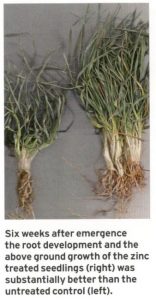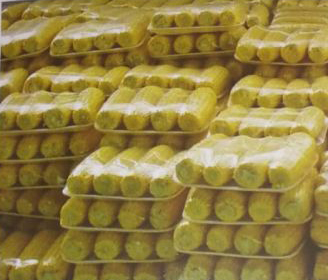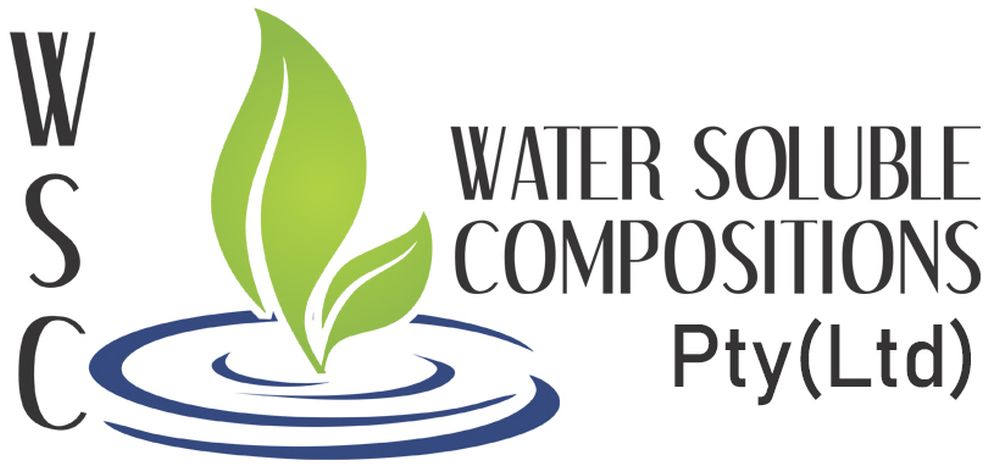Countrywide experiments during 2009/2010 season with different crops showed substantial yields an increase in quality with zinc sulphate applied as a foliar spray or as a fertiliser to the soil.
A large number of South African agricultural soils are known to be zinc deficient which negatively affects optimal crop production. Andre Immelman with other interested parties began an awareness programme in 2008 to stress the importance of zinc as a trace element in crop production. The focus of this program was to make farmers aware of the advantage off zinc as a micronutrient in plant nutrition in the correct for and quantity.
In 2010 they appointed a team of regional representatives to support farmers with technical advice and service with regards to the use of zinc sulphate. Their recommendations were based on the results of soil analyses, in which zinc was supplemented to the level that would supply the plants needs. The ideal zinc concentration in the soil is between 6ppm and 10ppm. A number of field trials where conducted to show the farmers the value of zinc as a supplement. Feedback of trials below.
Peanuts
Foliar application of zinc made on peanuts in North West where a zinc deficiency was identified. Results of the zinc application could clearly be seen in the improved growth of the plants. This experiment was conducted in Wolmaransstad area on dryland peanuts. A complete foliar feed programme that consisted of nitrogen, phosphate and potassium as well as the micronutrients iron, zinc, manganese, copper, boron and molybdenum was applied. A further 3kg/ha zinc sulphate was added to the spray mixture. The treatment was applied twice. A average yield of 2 930kg nuts per hectare was harvested. This was 50% more than the average region and 30% higher than the previous year. In addition, grade improvement of an average of 8% were achieved on the choice grades and on other grades. The application increased income by R2680/ha. The cost of the zinc applied was less than R250/ha.
Babala
On a farm in the Stella district in the North West the farmer noticed that fodder babala and maize planted on the dandy soils showed a typical yellowing symptoms every year at a young stage. After applying 25kg/ha zinc sulphate mono-hydrate, the plants had a healthy green colour throughout the season and improved yields
Maize
On the farm of Mr JJ Linde in the Verkeerdevlei area in the Free State, foliar sprays of a 0.5% concentration of zinc and boron at 1kg/ha were applied on maize that showed zinc deficiency symptoms six to eight weeks after emergence. An excellent yield of 5,2tons/ha was obtained. This was far better than the 3,6tons/ha long-term average of the surrounding areas. It was easy to apply the product as a foliar spray and costs was low, according to Mr. Linde. The results obtained was very satisfying. He also conducted an experiment with oats where the zinc sulphate was mixed with the fertiliser before planting . This also achieved good results. The growth of the oats was better and taller and gave substantially more bales of fodder per hectare.
Wheat
On Mr Koos Pienaar’’s farm near Theunissen in the Free State, wheat seed was inoculated with zinc sulphate mono-hydrate. To each 25kg of seed, 1kg of zinc sulphate was added with 500ml water and a small quantity of white sugar. Six weeks after emergence, the root development and above ground growth of the treated seed was substantially better than the untreated seed. The wheat was also sprayed with 12,5kg zinc sulphate hepta-hydrate (22%Zn) in 600 litre water, of which 200ltre/ha was applied. Three weeks after the foliar spray, the leaf growth was above average and the root development much stronger.
Sugar Cane
Two 10 hectare trial blocks of sugar cane was planted, a treated block and a control block. At planting, 25kg/ha of zinc sulphate mono-hydrate was applied on the treatment block. The plants were healthier, with more leaves and better stand than the control block. Mr Brian Korff of Woodgard Farm near Eshowe in Kwazulu-Natal, applied zinc to both sugar and bananas and says that there has been a noticeable improvement in the general appearance of is crop
Vegetables
A vegetable farmer from Pretoria obtained excellent results in an experiment with three lettuce cultivars. The treatment comprised of 50kg/ha of a mixture of zinc sulphate mono-hydrate (35% Zn granules), copper sulphate penta-hydrate (25% Cu) and zinc sulphate hepta-hydrate (22% Zn). The lettuce heads were weighed at harvest. The heads of the three cultivars were heavier by 7,33%, 21,82% and 9,85% than the control.
Sweetcorn
Mr Tertius Odendaal from Grootvlei in the Pyramid area north of Pretoria wrote to Mr Andre Immelman saying the following: “A representative visited me on my farm and identified a zinc deficiency in my sweetcorn. A foliar application of 10kg zinc sulphate and 100kg urea in 200 litre was applied through the irrigation system. Two applications were made.
“Due to the zinc application I harvested 30 000 marketable sweetcorn cobs per hectare. This was a substantial increase over the previous crop yielded 24 000 cobs per hectare. The cobs of the zinc-treated plants wee much better than the untreated sweetcorn. The cobs were bigger and of a better quality as they filled up to the end”
Green Beans
“I also sprayed 5kg zinc sulphate in 200 litre water on 0,33 hectares of green beans. This also showed a notable improvement. In the previous season a yield of 8 tons/ha was harvested and with the zinc treatment an average of 10 tons/ha was obtained. Results proof that by adding zinc to any crop makes a big difference in your yield per hectare.

The result of tow foliar applications with zinc sulphate was increased of 25% in marketable sweetcorn cobs per hectare. The cobs were bigger, filled to the end and were of a better quality.
